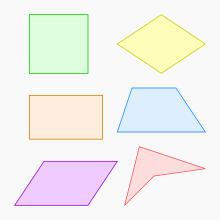| Quadrilateral | |
|---|---|
 Some types of quadrilaterals | |
| Edges and vertices | 4 |
| Schläfli symbol | {4} (for square) |
| Area | various methods; see below |
| Internal angle (degrees) | 90° (for square and rectangle) |
In geometry a quadrilateral is a four-sided polygon, having four edges (sides) and four corners (vertices). The word is derived from the Latin words quadri, a variant of four, and latus, meaning "side". It is also called a tetragon, derived from Greek "tetra" meaning "four" and "gon" meaning "corner" or "angle", in analogy to other polygons (e.g. pentagon). Since "gon" means "angle", it is analogously called a quadrangle, or 4-angle. A quadrilateral with vertices , , and is sometimes denoted as .[1]
Quadrilaterals are either simple (not self-intersecting), or complex (self-intersecting, or crossed). Simple quadrilaterals are either convex or concave.
The interior angles of a simple (and planar) quadrilateral ABCD add up to 360 degrees, that is[1]
This is a special case of the n-gon interior angle sum formula: S = (n − 2) × 180° (here, n=4).[2]
All non-self-crossing quadrilaterals tile the plane, by repeated rotation around the midpoints of their edges.[3]
- ^ a b "Quadrilaterals - Square, Rectangle, Rhombus, Trapezoid, Parallelogram". Mathsisfun.com. Retrieved 2020-09-02.
- ^ "Sum of Angles in a Polygon". Cuemath. Retrieved 22 June 2022.
- ^ Martin, George Edward (1982), Transformation geometry, Undergraduate Texts in Mathematics, Springer-Verlag, Theorem 12.1, page 120, doi:10.1007/978-1-4612-5680-9, ISBN 0-387-90636-3, MR 0718119





